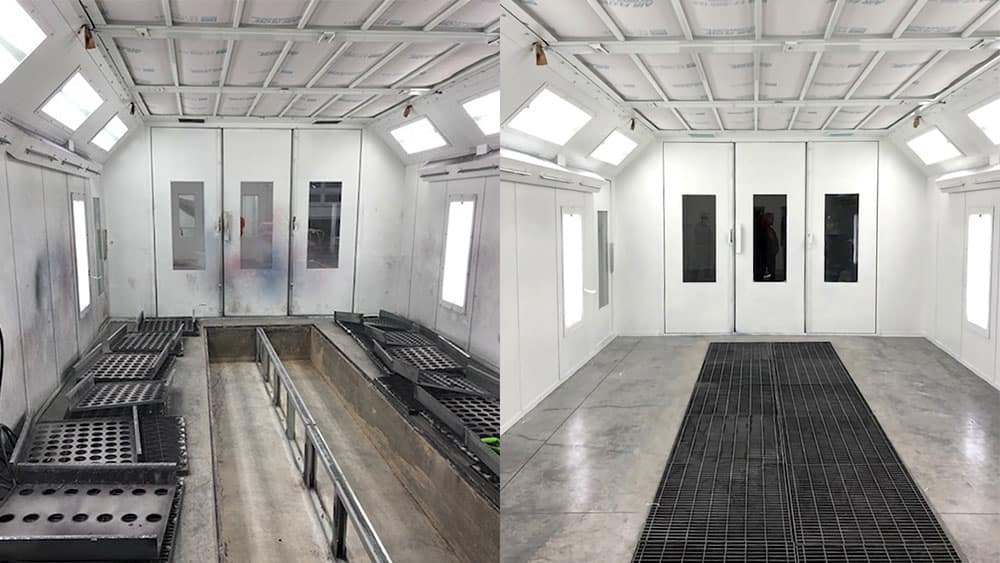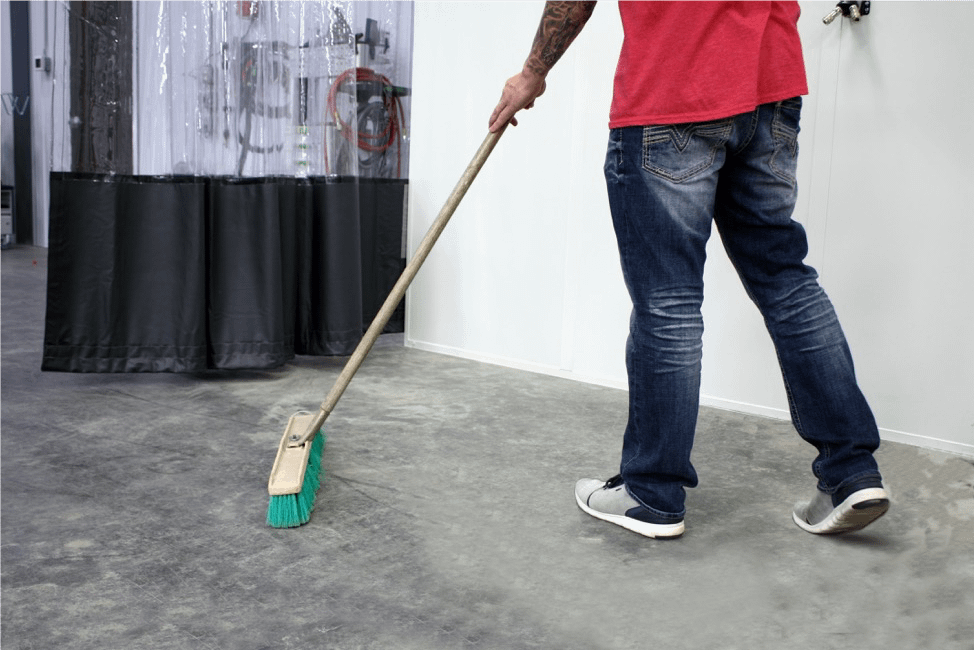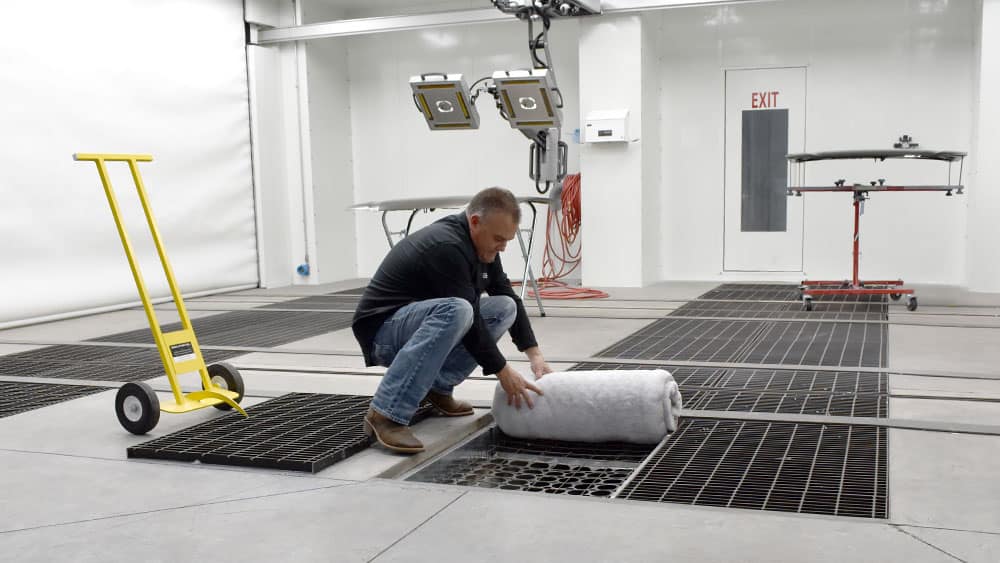
In today’s climate, nothing has been on our minds and in our newsfeeds more than proper hygiene and cleaning methods. Whereas proper cleaning in your workspaces, common spaces and frequently touched locations is critical to reducing the spread of germs and keeping everyone healthy, proper cleaning and maintenance methods in the paint booth contribute to higher quality paint jobs, less rework, longer-lasting parts and components, and the protection of your employees and facility.
In order to ensure your booth continues to operate in peak condition, paint booth maintenance needs to occur on a regular basis. To establish a maintenance schedule, it is best to refer to the schedule provided by the spray booth manufacturer. The schedule should provide guidelines for how often to inspect, clean and replace key components of your paint booth, such as intake and exhaust filters.
The following is a checklist of recommended cleaning and maintenance procedures for paint booths. Some components should be inspected and cleaned on a daily basis, while others may only need to be looked after annually, depending on your paint booth usage:
The interior of the paint booth collects overspray over time. For better quality finishes and safer working conditions, the booth walls and floors should be cleaned regularly. Maintaining the cleanliness of the floors and walls of the paint booth is important to keep dirt and dust out of the paint job — for better quality finishes and safer working conditions.

On a daily basis, the paint booth floors should be swept while the booth is in operation, unless it is a completely grated floor. As needed, paint booth walls can be cleaned with a soft cloth dipped in soapy water or weak detergent solution, and a non-ferrous, non-sparking scraper. Whichever method you choose for cleaning, make sure it is approved for use in hazardous locations so as not to ignite flammable overspray.
Paint booth protection products — such as floor paper and Booth Shield® peelable booth coatings from Global Finishing Solutions® (GFS) — are a simple way to protect your booth surfaces and prevent overspray buildup. Once soiled, these products can be quickly removed and reapplied. Another paint booth floor product that helps to trap dust and overspray is the PIG® Grippy® Adhesive Mat. This durable, padded mat can be vacuumed daily to remove contaminants.
One of the critical tasks in your maintenance schedule is regular filter changing. Filters should be changed regularly to ensure your paint booth continues to run properly and to prevent damage to the fan and other booth components. Clogged filters also slow airflow, allowing dirt and dust to collect in the paint booth.

When determining how often to change your paint booth filters, look at your booth’s work hours, as workload may change from week to week or season to season. Depending on your paint booth and filter, exhaust filters should be replaced at around 50 to 70 paint jobs, or when indicated by the manometer.
In addition to intake and exhaust filters, you may also have filters in your air heater, control panel or accelerated curing systems, such as AdvanceCure®. Make sure that you have identified all of the areas in your paint booth where you have filters and continually monitor and replace them as needed.
When it comes to replacing paint booth filters, make sure that the filter media completely covers the intake filter rack and the exhaust chamber or diffuser trays. Also, do not peel back corners of the filters to allow air to flow through when the filters are loaded. Both of these practices can result in damage to the booth’s exhaust.
An easy way to stick to a regular maintenance schedule and ensure your paint booth stays in peak condition is to take advantage of preventative maintenance and service programs offered by paint booth manufacturers, such as Global Finishing Solutions or your local distributor. These programs can be customized to your needs and may include just-in-time filter replenishment and replacement, paint booth cleaning, peelable booth coating application, complete diagnostic checks and emergency service.
Some programs also include weekend and after-hours service to fit within your shop’s schedule and reduce downtime. Preventative maintenance programs can save your business a significant amount of time, hassle and costly repairs down the road.

In addition to protecting your employees and facility, routine cleaning and maintenance of your paint booth will ensure it lasts for many years to come. A small investment in time and replacement filters now will result in long-term savings of costly repairs or even booth replacement.
One of the best ways to highlight your business is through a story that you can share across your online platforms. It humanizes your business and shows that your business can make a meaningful impact. Your testimonial would be used as a project profile on the GFS Booth Blog and can be shared on your website and/or social media channels.
Complete this form and we’ll be in touch to showcase your company.

Shop a variety of GFS aftermarket products, including booth protection products and mobile accelerated curing units. And enjoy the convenience of fast and free ground shipping throughout the contiguous United States.

Located at GFS’ headquarters in Osseo, Wisconsin, the Center for Excellence is an innovative facility featuring an automotive refinish training center, as well as a separate space dedicated to technical product training.

GFS is continuously searching for talented, ambitious individuals to join our team. We aim to provide our employees with every opportunity to make an impact on the company and find their niche along the way — weather in a production, field services or an office position.